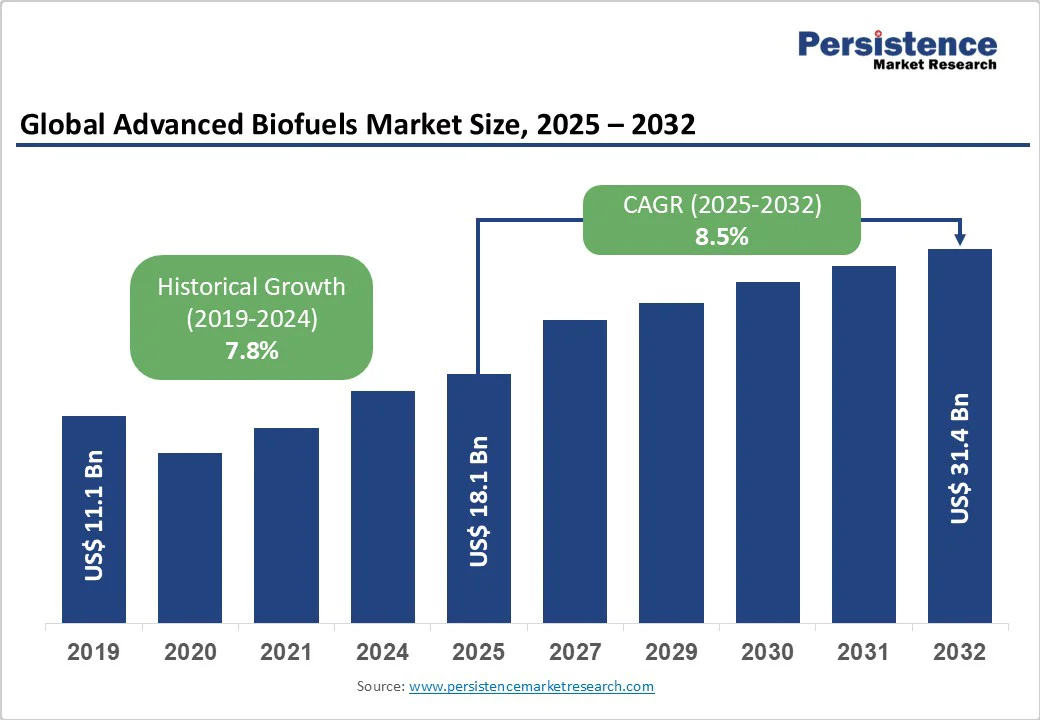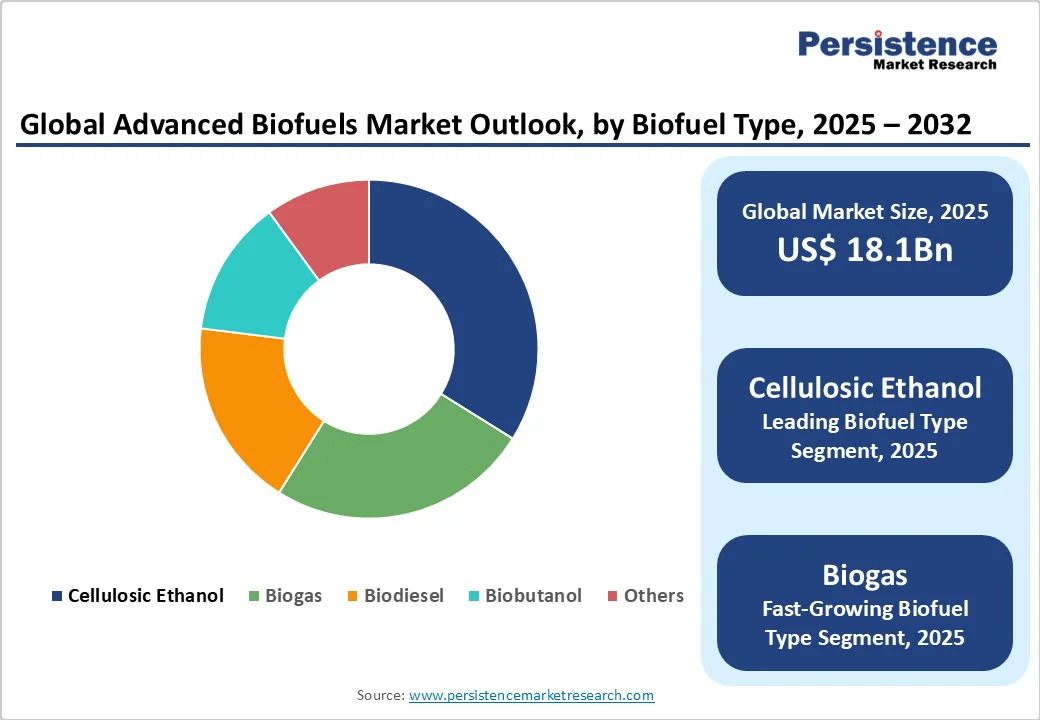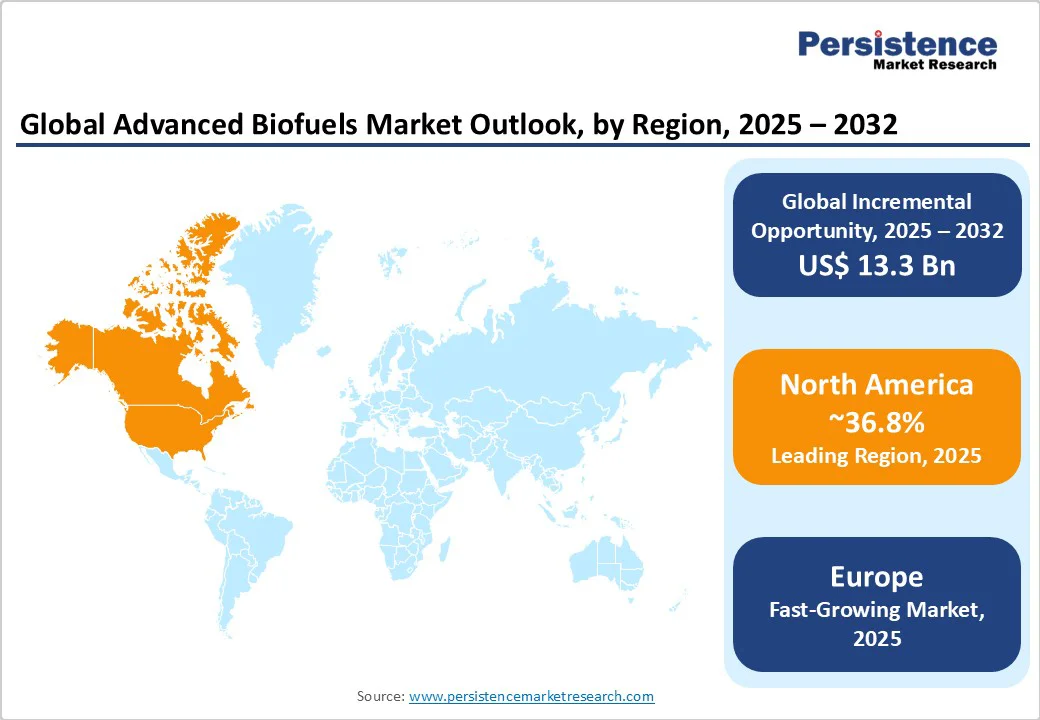ID: PMRREP10142| 192 Pages | 29 Sep 2025 | Format: PDF, Excel, PPT* | Energy & Utilities

The global advanced biofuels market size is likely to value at US$18.1 Bn in 2025 and reach US$31.4 Bn by 2032, growing at a CAGR of 8.5% during the forecast period from 2025 to 2032. The advanced biofuels market is witnessing robust growth, driven by the growing demand for sustainable energy solutions amid global efforts to reduce carbon emissions and transition from fossil fuels.
| Key Insights | Details |
|---|---|
|
Advanced Biofuels Market Size (2025E) |
US$ 18.1Bn |
|
Market Value Forecast (2032F) |
US$ 31.4Bn |
|
Projected Growth (CAGR 2025 to 2032) |
8.5% |
|
Historical Market Growth (CAGR 2019 to 2024) |
7.8% |

The global advanced biofuels market is experiencing accelerated growth due to the surging demand for low-carbon fuels in the transportation and aviation sectors, where decarbonization is a pressing priority. Advanced biofuels provide a drop-in solution for conventional engines, reducing lifecycle emissions compared to fossil fuels, making them ideal for hard-to-abate sectors. In the U.S., the Renewable Fuel Standard (RFS) mandates over 5 billion gallons of advanced biofuels annually by 2025, driving production expansions in cellulosic ethanol facilities.
Europe's ReFuelEU Aviation initiative requires 6% sustainable aviation fuel (SAF) uptake by 2030, spurring investments in biodiesel and biobutanol for jet fuel blending. Companies such as POET-DSM Advanced Biofuels LLC reported production increase in 2024, attributed to airline partnerships for SAF. Asia's growing air travel, with India's aviation sector expanding, further amplifies demand. . This driver not only addresses climate imperatives but also enhances energy independence, positioning the advanced biofuels market for exponential growth through 2032 as global fleets electrify more slowly than anticipated.
The advanced biofuels market grapples with significant restraints stemming from high production costs and ongoing technological maturity issues, which limit scalability and competitiveness against cheaper fossil fuels. Feedstock processing, particularly for lignocellulosic and algal sources, involves energy-intensive steps such as pretreatment and fermentation, inflating costs over conventional biofuels. In emerging markets, supply chain inefficiencies exacerbate expenses, with raw material sourcing costs rising due to seasonal variability.
Biochemical processes face enzyme degradation challenges, reducing yields, while thermochemical methods produce syngas impurities requiring costly purification. Regulatory hurdles, such as varying certification standards under the U.S. EPA's RIN program, add compliance burdens, particularly for startups such as KiOR Inc. These factors constrain market penetration in cost-sensitive regions such as Latin America, where adoption lags, ultimately hindering the sector's potential despite environmental benefits.
The increasing focus on renewable energy integration and electric vehicle supply chains presents significant opportunities for the advanced biofuels market. Advanced biofuels serve as drop-in fuels for renewable energy storage and EV manufacturing, such as biogas for grid balancing and biobutanol for battery production processes. The IEA projects global renewable energy capacity to grow by 2.5 times by 2030, with biofuels playing a key role in hybrid systems for remote power generation.
In the EV sector, advanced biofuels are used in feedstock-derived chemicals for lithium-ion batteries, with companies such as DuPont Industrial Biosciences innovating bio-based electrolytes to reduce reliance on petroleum. The EU’s Green Deal allocates €1 trillion for sustainable mobility by 2030, incentivizing biogas and biodiesel for heavy-duty EVs. GranBio's expansion in Brazil highlights tailored solutions for energy storage, aligning with sustainability trends. Government incentives, such as the U.S. Bioenergy Program for Advanced Biofuels, further encourage investments in green technologies, creating opportunities for manufacturers to develop advanced, scalable biofuels to meet evolving industry needs through 2032.

North America leads the advanced biofuels market with a commanding 36.8% share in 2025, anchored by the United States' mature infrastructure and policy-driven ecosystem that prioritizes energy security and emissions reductions. The U.S., producing the majority of regional output via cellulosic ethanol from corn stover, benefits from mandates such as the Renewable Fuel Standard that drive substantial biofuel production, spurring investments in advanced facilities such as those operated by POET-DSM.
Canada's Clean Fuel Standard aims to reduce greenhouse gas emissions, boosting biogas production from dairy waste in regions such as Ontario. Robust research and development funding supports innovation in areas such as algal biodiesel, while trade agreements facilitate biofuel exports. Key drivers include growing demand from the aviation sector, with airlines sourcing sustainable aviation fuels, and strong agricultural synergies providing abundant biomass. The region’s technological advantage and market maturity position it for sustained leadership in advanced biofuels through the coming decade.
Europe is the fastest-growing region with a projected surge fueled by the EU's Green Deal aiming for 40% renewable energy by 2030 and stringent CO2 targets for transport. Germany leads with biochemical ethanol plants processing lignocellulosic waste, supported by substantial recovery funds, achieving significant biofuel blends in diesel. Sweden’s biogas initiatives, converting a large portion of organic waste, power public transit in Stockholm, according to the Swedish Energy Agency.
The ReFuelEU mandates a major share of sustainable aviation fuel by mid-century, driving thermochemical investments in biobutanol for airlines. France’s jatropha trials in southern regions utilize marginal lands, enhancing feedstock diversity. Key drivers include circular economy policies and sizable innovation grants, positioning Europe for rapid expansion in sustainable aviation and heavy-duty vehicle sectors.
The Asia Pacific ranks as one of the fastest-growing regions driven by rapid industrialization, urbanization, and strong national commitments to carbon neutrality in major countries such as China and India. China leads with thermochemical biogas plants utilizing rice husks, aiming to increase the share of non-fossil fuels under its national plans, producing significant volumes annually.
India's National Biofuel Policy promotes biodiesel from camelina, supported by extensive jatropha plantations. Southeast Asia’s algal projects leverage coastal resources to boost exports. Key drivers include subsidies that offset capital expenditures and air quality mandates that reduce urban emissions substantially. This region’s vast biomass availability and responsive policies are fueling dynamic market growth.

The global advanced biofuels market is intensely competitive, dominated by a mix of established energy giants and specialized biotech firms leveraging innovation and strategic alliances for market penetration. Characterized as moderately consolidated, the landscape features key players with integrated supply chains from feedstock to end-use, alongside agile startups focusing on niche technologies. Regional dynamics influence competition, with North American firms emphasizing scale and Europe-Asia players prioritizing sustainability certifications. Investments in R&D for cost-efficient processes and partnerships with oil majors enhance resilience, as demand for drop-in fuels intensifies in transportation.
The advanced biofuels market is projected to reach US$18.1 Bn in 2025.
Growing demand for low-carbon fuels in transportation and aviation, along with expanding feedstock availability, are the key market drivers.
The advanced biofuels market is poised to witness a CAGR of 8.5% from 2025 to 2032.
The expanding applications in sustainable aviation fuels and policy incentives in emerging economies represent key market opportunities.
Abengoa Bioenergy, S.A., POET-DSM Advanced Biofuels LLC, DuPont Industrial Biosciences, and Clariant Produkte GmbH are key market players.
| Report Attribute | Details |
|---|---|
|
Historical Data/Actuals |
2019 - 2024 |
|
Forecast Period |
2025 - 2032 |
|
Market Analysis |
Value: US$ Bn/Mn, Volume: As Applicable |
|
Geographical Coverage |
|
|
Segmental Coverage |
|
|
Competitive Analysis |
|
|
Report Highlights |
|
By Biofuel Type
By Process Type
By Raw Material
By Region
Delivery Timelines
For more information on this report and its delivery timelines please get in touch with our sales team.
About Author